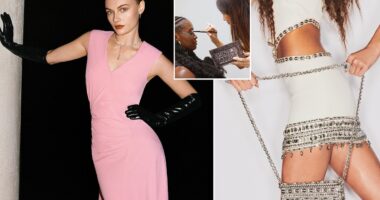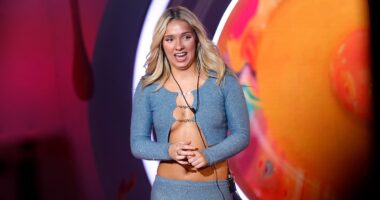Share to Facebook Share to Twitter Share to Linkedin This is the published version of Forbes’ CMO newsletter, which offers the latest news for chief marketing officers and other messaging-focused leaders. Click here to get it delivered to your inbox every Wednesday. Marketing and sponsorship disputes have gone to the dogs. Hot dogs, that is. News broke yesterday that Joey Chestnut, 16-time winner of the Nathan’s Hot Dog Eating Contest on July 4, has been barred from competing because he signed an endorsement deal with a rival hot dog brand: plant-based Impossible Foods. Major League Eating, which runs the annual contest, issued a statement on X yesterday saying they were “devastated” that Chestnut has chosen to represent a rival brand. For nearly two decades, the statement says, Major League Eating has worked with competitors “under the same basic hot dog exclusivity provisions.” According to the Washington Post, Chestnut’s contract with Nathan’s had expired and the two sides were negotiating a new one—reportedly that would give Chestnut an annual $300,000 appearance fee over four years—when Chestnut said he’d signed a deal with a plant-based company. George Shea, chair and cofounder of Major League Eating told the Post contract negotiations reached an impasse when Chestnut said that he would not entertain a “carve-out,” representing just the plant-based products in Impossible’s portfolio that aren’t hot dogs. However, the sponsorship requirements of the Nathan’s Hot Dog Eating Contest gave Impossible Foods a much bigger opportunity to share its message than just signing Chestnut. After the initial excitement around the category as it started to grow about five years ago, plant-based meat has faced an issue that traditional marketing hasn’t yet been able to solve: Sales have slumped because the products often don’t deliver the same experience of eating meat and can be more expensive. It’s been tough for the companies to land on a value proposition to present to their target consumers. Impossible Foods, one of the leading companies in the space, kicked off a campaign last month that frames its products as meat, too—just from plants. Chestnut is one of the most well-known carnivores in the nation, and a key person to push forward Impossible’s new marketing campaign: Impossible’s Beef Hot Dog still is meat. However, Major League Eating’s ban of Chestnut is reinforcing that message. If they didn’t consider Impossible to actually be a competitor, it’s likely that Chestnut would be in the lineup to down dogs on Coney Island again this July 4. And because the Nathan’s Hot Dog Eating Contest is such a quirky Independence Day tradition, the story about Chestnut—and Impossible Foods—is appearing in hundreds of news feeds. Impossible Foods should seize on this opportunity to reinforce its message, maybe even with more messaging directly from Chestnut. After all, it is just about time for July 4 barbecues. Historically, plant-based meats sell better during grill season, and this is a golden opportunity for Impossible to really prove that it can take the place of traditional meat. June is Pride Month, but many brands are less awash in rainbows this year than they have been in the recent past. There are two reasons: Backlash against LGBTQ+ campaigns last year led to consumer boycotts and negative publicity, and brands are realizing they need to more authentically market to the LGBTQ+ community. I talked to Phil Schraeder, who is CEO of contextual marketing intelligence company GumGum and a member of the LGBTQ+ community, about how brands are reaching them. An excerpt from our conversation is later in this newsletter. SOCIAL MEDIA Nikolas Kokovlis/NurPhoto via Getty Images The latest big change in the social network formerly known as Twitter has rolled out. Elon Musk, owner of X, confirmed in a post that “likes” will now be automatically hidden. This move has been talked about by many in the upper levels of X, and was made official this week. X director of engineering Haofei Wang talked about the change in an X post last month, saying, “Public likes are incentivizing the wrong behavior … many people feel discouraged from liking content that might be ‘edgy’ in fear of retaliation from trolls, or to protect their public image.” Paid X users have had this feature since last summer. This is another example of a change made on X that may not be popular with users, but fits in with other policies Musk has instituted to protect speech that may come from more fringe voices. User verification was discontinued and content moderation policies became far less stringent. And just last week, X updated its policies to allow pornography—as long as it is consensual, involves adults and includes a content warning. While these changes serve Musk’s personal beliefs in free speech, it’s unclear if they will help X’s bottom line. As a private company, X does not report its revenues, but many advertisers have left the platform. Last October, Insider Intelligence estimated that the company’s 2023 ad revenues would be $2.9 billion—a more than $1 billion drop from 2022, largely due to “brand safety issues, confusing policies and broken technology.” BRANDS + MESSAGING A Chanel store in Bangkok, Thailand. Lauren DeCicca/Getty Images Luxury just isn’t worth what it used to be. The perception of value of many of the world’s top luxury brands has fallen on the Global RepTrak 100 study, which examines how consumers see brands across several dimensions, writes Forbes senior contributor Pam Danziger. In this year’s list, Rolex is ranked third, Dior is 28, and Burberry, LVMH, Hugo Boss, L’Oreal and Hermes are in the bottom 10. Prada didn’t even make the top 100, and Burberry, LVMH, L’Oreal and Hugo Boss have all seen their rankings drop 30 spots or more since 2022. While it’s never a good time for brands to lose value, now is a critical time for luxury brands to rebuild their image among consumers. In 2024, Danziger writes, Bain analysts expect a “relatively soft” personal luxury goods market. But considering that growth has been slowing since 2022—down from 28% in Q1 of 2022 to 12% in Q4—that does not bode well for the segment. Danziger writes rebuilding that reputation depends on luxury goods being worth the price, becoming more culturally sensitive and being better corporate citizens. Chanel is potentially about to make many of those changes, Danziger writes. Creative director Virginie Viard just left the fashion house, so CEO Leena Nair is looking for her replacement. She came to Chanel in 2021 from Unilever, where she was chief human resources officer. Danziger writes that her experience in finding talent, coupled with Chanel’s recent revenue and sales success make her well positioned for the challenge. NOW TRENDING Scott Olson/Getty Images A strong brand is extremely valuable, and analysts reminding investors about that gave a big boost to Krispy Kreme’s stock price this week. In March, Krispy Kreme announced a partnership with McDonald’s through which the fast food chain will sell the chain’s doughnuts. On Monday, an analyst report from Truist upgraded Krispy Kreme’s stock to “buy,” claiming investors are undervaluing the business potential of the partnership, which begins later this year. The partnership will double the places where consumers can buy fresh Krispy Kreme doughnuts. Investors responded accordingly, and share prices are up more than 10% this week so far. In the recent past, Krispy Kreme has grown its business by expanding its Delivered Fresh Daily program, bringing its fresh-baked doughnuts to grocery stores, convenience stores and now QSR restaurants. As of February 2023, fresh Krispy Kreme doughnuts were available in 5,741 locations in the U.S. and Canada. When Krispy Kreme announced the partnership with McDonald’s in March, it had more than 14,000 places where people could buy fresh doughnuts. ON MESSAGE GumGum CEO Phil Schraeder On LGBTQ+ Marketing Inclusivity And Pride GumGum CEO Phil Schraeder. GumGum, Getty As marketing becomes more inclusive, brands are going further to target members of diverse communities, including those who are LGBTQ+. In recent years, this manifested itself with new campaigns, rainbows and partnerships around Pride Month in June—and that ended in backlash last year. I talked to GumGum CEO Phil Schraeder, who is part of the LGBTQ+ community, about what brands have learned about messaging to LGBTQ+ individuals, both during Pride and all year long. This conversation has been edited for length, clarity and continuity. A longer version of this interview can be found here. Are we seeing fewer rainbow flags this year in response to last year’s backlash against Pride, or is it a change in the way that companies are looking at the LGBTQ+ community? I think it’s a combination of both. From the backlash that we’ve seen—Bud Light, Dylan [Mulvaney], where brands are trying to position themselves as part of and supportive of the community through these one-off collabs, or these one-off campaign activations—we’re finding that brands recognize that isn’t going to land if it’s not truly authentic to what that brand stands for. They understand more the importance of laying a foundation of marketing strategy throughout their yearly programming, so that if they do decide to do a larger activation against Pride Month, for example, it’s not falling as just, ‘Oh, raise the [Pride] flag. You’re here. You’re trying to champion Pride, get our dollars, and then go the other direction.’ There’s a sensitivity. The brands that are confident in who they have been continue to show up. The brands who are trying to find the balance between understanding their existing consumers and their own values and building that effective bridge, you’re seeing a lot more work being done, because there is that concern of this backlash that has come. From your perspective, what is needed in terms of messaging content and context to make it inclusive? What marketers are realizing: Pride Month today versus Pride Month 10 years ago are completely different. Pride Month 10, 15, 20 years ago, were a couple letters. Now that’s extended and become a really clear piece of identity. Almost one-third of Gen Zers identify as part of the LGBTQ+ community, so this is not just a small segment of ‘We support Pride.’ There are so many people and extensions of people. The allyship is growing. The Gen Zs that identify are growing. This is actually critical to that piece of their growth as a brand, so the brands also have to make sure they’re aligning their creative and their messaging with, and speaking to, the Gen Z audience. Rethink as less of Pride strategy, more of: How am I always on to be in the consideration set for Gen Z, to look at my brand as someone that relates to them. I think it’s reviewing and understanding who’s influenced the activation before it even leaves the brand. And then second, really using your insights to focus on Gen Z as your core demo, and make sure that the message and the creative is there. It’s a lot more driven with emotion. We are looking for connection. We are looking for empathy. We are looking for support. We are looking for visibility. And I think those are the key messages that need to relate. We’re looking to hear stories. We’re looking to also understand what you bring with that brand into the community. There’s elements of extension. Just putting a “We support Pride” logo and hanging a flag outside of your brick-and-mortar store isn’t enough. We want to know that you’ve put the thought into that. It shows, and we can truly feel that this is something this brand really, really is passionate about through the way in which they message. How is messaging and connecting with the LGBTQ+ community different than messaging to and connecting with other communities, including racial, ethnic and religious minorities? There’s similar strategies. I would look at this as a foundation and then a build. At the foundation, you have to ask yourself, do you truly, as a leader, as a company, as a brand, believe and are authentic to truly believing in the equity and inclusion of these non-majority groups? If the answer is yes, as the brand, what are the values that you stand for? How are our values then making sure it shows true to our identity around what we do and where we show up? Then, it’s really understanding what is needed within that community. We talk a lot about equality versus equity. It’s not every year the same thing is needed, or you do the same for all. What is the equity? What is needed in your values? And maybe this Pride, or this period, you see that there’s a need from the community of your consumers, or who you’re looking at. This is how you’re going to position a Pride message. This is where we’re going to double down this investment and really go here, because this is what that community [needs]. It’s not the same because each non-majority group is experiencing different things, and they need the brands to be able to bring their brand to life, while also understanding what that group is experiencing in that time, so that it continues to evolve. And they’re showing they’re paying attention, and they’re adding value and supporting. For example, George Floyd[’s 2020 murder by police officers], when that happened, brands really needed to go and show alignment there. That’s what that community needed, and they needed to hear the support and the voice. And that evolves. This ‘Dust off last year’s Pride activation and just put it into place’ is not going to work. We see right through it. We know as a community what we’re struggling with: Trans youth and the laws changing. Rights of LGBTQ+ stuff being gradually eradicated from various states subtly. Books being banned. There’s a lot of different tensions of things happening right now. So how are you understanding that, and then using that as a critical input into how you message to us? FACTS + COMMENTS Comfortable—but clunky and ugly—shoes are seeing record sales as consumer preferences and marketing tactics lift brand profiles. $524 million: Birkenstock’s revenues for the quarter ending March 31—a year-over-year growth increase of 22% 14.7%: Year-over-year increase in Q1 revenues for the Crocs brand of foam clogs and shoes ‘They’re a kind of anti-fashion that people buy into’: GlobalData Managing Director and Retail Analyst Neil Saunders told Forbes STRATEGIES + ADVICE Purposeful leadership can help you make the greatest impact on your company. Here’s an ABC guide to some of the qualities that can improve the way you lead. Are you looking for ways to be more innovative? Generative AI can help, but it should only be a first step. QUIZ The YouTube channel associated with which entity has the most subscribers as of last week? A. Indian music label T-Series B. K-pop band BTS C. Influencer MrBeast D. Pop star and cultural phenomenon Beyoncé See if you got the answer right here.
Subscribe
Login
0 Comments





